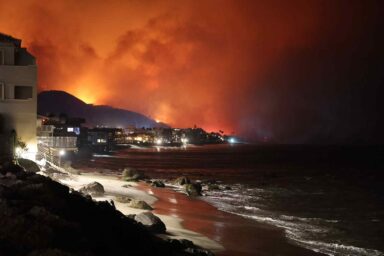A new analysis finds extreme warming events in the ocean have increased relative to the very far past, with nearly 60 percent of the ocean experiencing extreme heat in 2019
This story by Krystal Vasquez originally appeared in EOS and is republished here as part of Covering Climate Now, a global journalism collaboration strengthening coverage of the climate story.
Extreme marine temperatures that were once considered rare have officially become the norm for the majority of the world’s ocean. According to a new study, more than half the marine surface is now regularly subjected to extreme heat. These abnormally high temperatures can have far-reaching, negative effects on marine animals as well as the local economies that depend on them.
“We need to realize that climate change is happening as we speak. … It has also been happening for quite some time,” said study coauthor Kisei Tanaka, a marine ecologist at NOAA.
Prior to his position at NOAA, Tanaka was a research data scientist at the Monterey Bay Aquarium in California. While he was there, he and Kyle Van Houtan, chief scientist at the aquarium at the time, noticed some unusual changes happening in the bay. Kelp forests were disappearing, and marine species whose normal habitat was the warmer waters of Southern California were starting to appear farther north.
To better understand what was driving these changes, “We wanted to have an index of extreme marine heat,” said Van Houtan, now the president and CEO of Loggerhead Marinelife Center in Florida. But surprisingly, one didn’t exist, at least not one that fulfilled the criteria they needed. Previous historical studies rarely extend past the 1950s, which “is far too late in already a much-changed system,” explained Van Houtan.
What was once a “50-year type of temperature event has become an every year type of event.”
To map how these extreme heat events in the ocean have evolved over the course of recent history, Tanaka and Van Houtan analyzed extensive sea surface temperature records dating back to the late 19th century. They found that between 1870 and 1919 — a period corresponding to the second Industrial Revolution — extreme heat events were relatively rare, affecting only 2 percent of the ocean’s surface at any given time. But within the next century, this figure climbed past 50 percent “and never went back down,” explained Tanaka. As a matter of fact, it rose further; by 2019, almost 60 percent of the ocean had been plagued with extreme heat.
What was once a “50-year type of temperature event has become an every year type of event,” said Tanaka, who noted that some parts of the ocean have even begun experiencing these extreme temperature events “every single calendar month.”
Tanaka and Van Houtan’s work “back[s] up all the studies that show increased warming events in the ocean as we progress to the 21st century,” said Sofia Darmaraki, a physical oceanographer at Dalhousie University in Nova Scotia, Canada, who was not involved with this work. “It shows that humans are, indeed, having an impact on the ocean.”

Crossing the Threshold
For marine temperatures to be considered “normal,” they have to regularly occur across the majority of the ocean’s surface. This threshold is defined as “the point of no return.” Although the global ocean officially hit this point back in 2014, Tanaka and Van Houtan discovered that some ocean basins had actually crossed this threshold more than a decade earlier. The South Atlantic, for example, reached this point as far back as 1998.
“This is an indication that maybe the warming of the ocean is happening faster than we think,” added Darmaraki.
The study also makes it clear that climate change is “not just some future scenario happening 20 years, 50 years down the line,” said Tanaka.
“The ‘point of no return’ was more of a statistical description of the time series.” It’s not a permanent state that cannot be reversed.
Even so, there’s still hope. As Van Houtan explained, “The ‘point of no return’ was more of a statistical description of the time series.” It’s not a permanent state that cannot be reversed. In addition, although 50 percent of the Southern and South Pacific Ocean basins have experienced heat events in the recent past, they have yet to become a regular phenomenon. “There are still places on the planet which are relatively cold,” said Darmaraki, and “It’s crucial that we protect these important climate refugia.” But to do this, Tanaka argues that we need to work together to meet the Paris Agreement targets. Scientists, stakeholders, and fisheries managers will also need to collaborate “to improve the strategies for adaptation and planning,” added Darmaraki.
There are “so many good ways that we can reduce our impact of climate change and hopefully reverse it,” Van Houtan said.
Krystal Vasquez (@caffeinatedkrys), Science Writer



